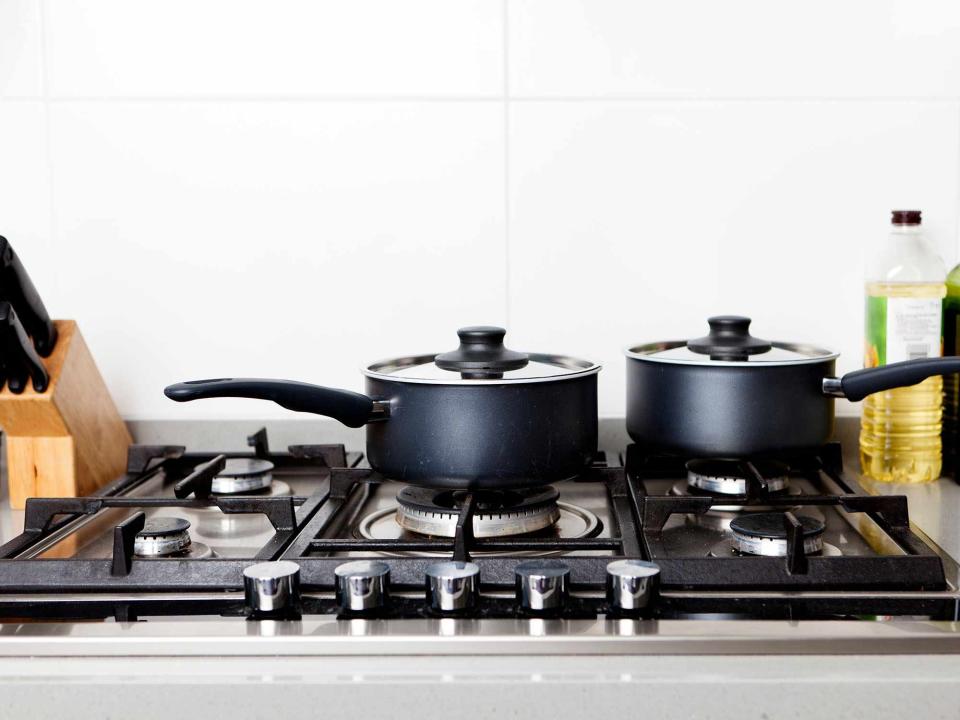Gas vs. Electric vs. Induction Stovetops: How Do They Compare?
The details that distinguish the three major categories of stoves — plus, the benefits and drawbacks of each.

Getty images
Stoves, the humble cooking appliance at the heart of every kitchen, have had a starring role in the news recently. There have been calls to ban certain types of stoves and simultaneous calls to subsidize others.
But in order to make sense of the debate and see where you fall, you first need to understand the different types of stoves. Here, we’ll break down the three most common categories — gas, electric, and induction — and explain the benefits of each.
What Is a Gas Stove?
When you picture a stove in your head, it’s most likely a gas stove. The distinctive feature of a gas stovetop is the open flame which heats the pan from below. The stove is connected to a dedicated gas line which feeds the flame and controls the amount of heat.
Related: How to Clean Gas Stove Burners
Benefits of a Gas Stove
Instantaneous Heat. One of the reasons gas stoves are so popular is that the heat is instantaneous. With just a switch of a knob, you can go from no heat to full heat immediately.
Quick Removal of Heat. Likewise, when you’re done cooking you can shut off the entire heat source right away. This level of responsiveness allows cooks to dial in the exact amount of heat that’s right for the task at hand. This precise control and ability to provide a consistent level of heat can help to ensure uniform cooking.
Direct Charring. A gas stove can be used like a gas grill, providing direct charring for items like peppers and eggplant, something you’re not able to achieve on an electric or induction stove.
What Is an Electric Stove?
Unlike gas stoves which have grates that sit over the burners, electric stoves typically have a flat cooking surface made of a ceramic-glass blend. Instead of an open flame, electric stoves use heated metal coils to transfer heat to the cookware.
Related: 8 Habits That Can Ruin a Glass Stovetop
Unlike gas stoves, electric stoves do not heat up or cool down instantly. The electric coils can take a while to get to full heat and will retain their heat long after you turn off the stove. This is why recipes often say, “remove the pan from the heat” versus. “turn off the heat,” as electric stoves take a while to cool down.
Benefits of an Electric Stove
Potentially More Environmentally-Friendly. Because electric stoves don't run on methane, they don’t pollute the air as much as gas stoves do.
Stovetop Doubles as Counter Space. When not in use, the flat-top surface of an electric stove can double as useful counter space, which is especially helpful in smaller kitchens.
Easier Cleaning. To clean a gas stove, the grates have to be removed and the surface requires more twists and turns to clean. With an electric range, the flat surface just needs a quick wipe down.
What Is an Induction Stove?
Induction stoves are a distinct type of electric stove that use electromagnetism to heat the pan directly, unlike electric and gas stoves which indirectly heat up the pan through either a heating element or an open flame.
Benefits of an Induction Stove
Efficient Heat Transfer. By using electromagnetism, induction stoves are able to more efficiently transfer heat compared to both electric and gas stoves. The result is that cookware heats up faster on induction stoves.
Surface Never Gets Hot. Since induction stoves use electromagnetism, the surface of the stove never gets hot. You could place your hand directly on top of a “hot” stove and it would feel cool to the touch and you wouldn’t risk burning yourself.
The downside is that not all cookware works with induction stovetops. Most nonstick pans are not compatible with induction stoves, so you’ll need special nonstick pans that are specifically designed for induction cooking. Traditional carbon steel woks can also be problematic, as they don’t always lay flat on the induction surface. However, regular cast irons and stainless steel pans work well.
Related: The Best Induction Cooktops, According to a Chef
Additionally, induction stoves are typically more expensive than gas and electric stoves, though prices are declining and there are new rebates to help offset the increased cost.
Which Stove Is Best for You?
Now that you have a better lay of the land when it comes to your stovetop options, you may be wondering which type is best for you. There are pros and cons to all, so you need to prioritize what is most important to you. Gas stoves tend to be less expensive and preferred by serious chefs and avid cooks, but also have growing environmental concerns. Electric stoves are simple and can work great in smaller kitchens, but also require a slightly different cooking approach. Induction stoves are the new kid on the block and still fairly expensive with fewer options, but they potentially give you some of the best benefits of both gas and electric stoves.

